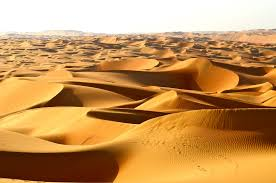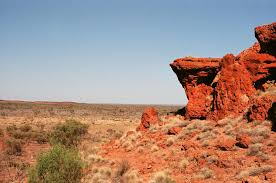 |
Chihuahuan Desert
The Chihuahuan Desert is an arid region that covers parts of western Texas, southern New Mexico, and northern Mexico. Because it lies at a higher altitude than the nearby Sonoran desert, the climate is slightly milder, although summer temperatures often top 110 degrees Fahrenheit. The region includes numerous basins and sub-ranges of the Rocky Mountains including the Guadalupe and Sacramento. It also includes Big Bend and Carlsbad Caverns National Parks.
Back to Top |
| |
|
 |
Mojave Desert
The Mojave desert extends through southern Nevada, northwestern Arizona, and parts of southeastern California. The region gets about six inches of rainfall per year. Most of the desert is between 3,000 and 6,000 feet in altitude. Summers are extremely hot. Some places, like Death Valley, regularly reach temperatures of 120 degrees Fahrenheit.
The Mojave is one of the most biologically rich deserts. About 2,000 species of plants have been documented.
Back to Top |
| |
|
 |
Namib Desert
The Namib Desert a coastal desert in southeastern Africa and one of the world’s most desolate places. The name "Namib" means "vast place." Few, if any, people live within the desert. The northern coast of Namibia is sometimes called the Skeleton Coast because of the high number of shipwrecks caused by intense fog formed by the interactions of wet, ocean air with the dry desert air.
Most of the desert lies along the coast of Namibia, with a small portion in southern Angola and northwestern South Africa. Stretching over 31,000 sq miles, the Namib desert is about the size of the state of Pennsylvania. This region typically gets less than 10 millimeters of precipitation a year, but the western portion of the desert gets only 5 millimeters of rain per year. A few plants species, which can survive off of desert fog, live within the Namib Desert.
Back to Top |
| |
|
 |
Sahara Desert
Covering 3.6 million square miles, the Sahara Desert is the world’s largest non-polar desert. It is also the world’s hottest and sunniest desert. Covering most of north Africa, the Sahara Desert is roughly the size of the entire United States. Windswept sand dunes in the desert can reach heights of nearly 600 feet. Parts of the Sahara Desert can go decades without receiving any rainfall. With some rare rainfall in the Sahara, the raindrops can evaporate before hitting the sandy surface.
Back to Top |
| |
|
 |
Gobi Desert
The Gobi Desert is a large area in northern China and Mongolia. At its longest, it stretches nearly 1,000 miles. The Gobi is a harsh region with very little precipitation and ferocious sandstorms. Summer temperatures can rise to as high as 113 degrees Fahrenheit, while winter temperatures frequently drop below zero. The Gobi Desert is most notable in history as being part of the Great Mongol Empire. Furthermore, many important trading posts along the famed Silk Road were located here. In 1923, scientists found dinosaur eggs in the first dinosaur nest ever found in the Gobi.
Back to Top |
| |
|
 |
Takla Makan Desert
The Takla Makan Desert is a large desert in western China. It extends about 600 miles from west to east. It is one of the largest sand deserts in the world and has played an important part in world history. Travelers on the Silk Road, the legendary trading route that linked Europe to Asia, had to pass through the mighty desert. In the 1980s, scientists found hundreds of 3,000 year-old mummies in the Takla Makan Desert. They believe the people were from an ancient civilization that once existed between Europe and Asia.
Back to Top |
| |
|
 |
Kalahari Desert
The great Kalahari Desert is located in southern Africa, principally in the nations of Namibia and Botswana. It extends nearly 350,000 square miles and is officially classified as semi-arid. Its name is thought to come from an old Tswana word that translates to "waterless." The conditions in the Kalahari are largely less harsh than in other deserts. Much of the desert is full of vegetation and is more savanna-like than desert-like. The Kalahari has a single permanent river, the Okavango, but is full of temporary reservoirs that form during the rainy season. The Kalahari is home to many iconic African species such as lions, cheetahs, hyenas, springbok, and secretary birds.
Back to Top |
| |
|
 |
Arabian Desert
The barren Arabian Desert stretches nearly 900,000 square miles from Yemen to the Persian Gulf and includes the entire nation of Saudi Arabia. It is the world's fourth largest desert and contains one of the largest continuous bodies of sand on the planet. It is the largest desert in Asia.
The Arabian Desert features extreme temperatures, aridity, and little biodiversity. Temperatures in the Arabian Desert remain constant throughout the year and highs range from 104 degrees Fahrenheit to 113 degrees Fahrenheit. On average, the desert collects no more than ten centimeters of rain per year. It is one of the sunniest places on Earth.
Back to Top |
| |
|
 |
Australian Desert
The Australian Desert covers about 18 percent of the Australian continent and extends roughly 530,000 square miles. It is divided into ten sub-deserts, the largest of which is called the Great Victoria Desert in southwestern Australia. Similar to the Kalahari, conditions are generally less harsh here than in other deserts, and most points in the desert receive at least 10-20 centimeters of precipitation in a year. Temperatures are very hot, although not extreme, and rarely exceed 105 degrees Fahrenheit. The Great Victoria Desert is characterized by savanna-like grasslands, sandhills, regions of densely packed pebbles called sand pavement, and salty lakes. Thunderstorms are common in the Great Victoria Desert.
Back to Top |
| |
|
 |
Patagonian Desert
The Patagonian Desert, located in southern Argentina, extends nearly 260,000 square miles and is the world's eighth largest desert. The Patagonian is a cold desert and temperatures average about 37 degrees Fahrenheit. This desert has two seasons: summer and winter. Summer lasts about five months and temperatures may rise above 50 degrees Fahrenheit. Even in winter, however, snow is rare given the arid conditions. The arid conditions of the region are caused by its location in the rain shadow of the Andes Mountains. Clouds that form over the ocean release precipitation as they are forced to rise over the towering mountains, leaving little or no precipitation as they descend the mountains toward the Patagonian Desert.
Back to Top |
| |
|
 |
Atacama Desert
Located in the northern Chile, the Atacama Desert is the driest non-polar region in the world. It averages a little less than an inch or precipitation per year, although some weather stations within the desert have NEVER recorded precipitation, and others only record precipitation once every three or four years. Because of its extreme aridity, the Atacama is referred to as a hyperarid desert. The region is so arid that even only the tallest peaks in the range have permanent snow coverage. Many mountains over 6,000 feet have no snow coverage.
The Atacama may be the world's oldest desert. Scientists believe it has been remained in a state of hyperaridity for at least three million years. Its aridity is attributed to its location in the rain shadows of two high mountain ranges - the Andes and Chilean Coast Ranges.
Back to Top
|
|